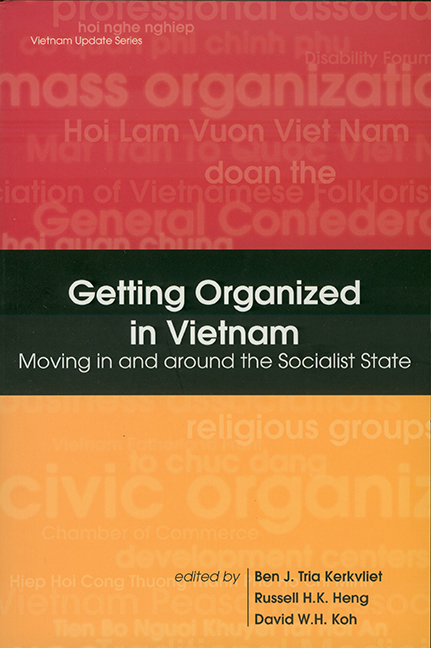Book contents
- Frontmatter
- Contents
- Preface
- Abbreviations
- Introduction: Grappling with Organizations and the State in Contemporary Vietnam
- 1 From Fence-Breaking to Networking: Interests, Popular Organizations, and Policy Influences in Post-Socialist Vietnam
- 2 Business Associations and Policy-Making in Vietnam
- 3 NGOs and Highland Development: A Case Study in Crafting New Roles
- 4 The Disabled and Their Organizations: The Emergence of New Paradigms
- 5 Authoritarian Governance and Labour: The VGCL and the Party-State in Economic Renovation
- 6 The Relationship between Civic and Governmental Organizations in Vietnam: Selected Findings
- 7 Donors, Local Development Groups and Institutional Reform over Vietnam's Development Decade
- Index
- About the Contributors
6 - The Relationship between Civic and Governmental Organizations in Vietnam: Selected Findings
Published online by Cambridge University Press: 21 October 2015
- Frontmatter
- Contents
- Preface
- Abbreviations
- Introduction: Grappling with Organizations and the State in Contemporary Vietnam
- 1 From Fence-Breaking to Networking: Interests, Popular Organizations, and Policy Influences in Post-Socialist Vietnam
- 2 Business Associations and Policy-Making in Vietnam
- 3 NGOs and Highland Development: A Case Study in Crafting New Roles
- 4 The Disabled and Their Organizations: The Emergence of New Paradigms
- 5 Authoritarian Governance and Labour: The VGCL and the Party-State in Economic Renovation
- 6 The Relationship between Civic and Governmental Organizations in Vietnam: Selected Findings
- 7 Donors, Local Development Groups and Institutional Reform over Vietnam's Development Decade
- Index
- About the Contributors
Summary
For many years it was quite common, in the analysis of the Vietnamese political system, for American and European political scientists to presuppose a mono-organizational model of state–society relations. This model is not or no longer appropriate. Current research on Vietnam indicates “that a multiplicity of changes is underway in this country” (Thayer 1995, p. 59). We do not want to discuss whether such models ever were appropriate for analyzing Vietnam's socio-political development. Nor do we want to speculate on whether there was much more local activity and scope for “everyday politics” in Vietnam in the 1960s and the 1970s than previously imagined, as Thayer put it (ibid., p. 59). Instead, we would like to offer some empirical evidence for the thesis that a remarkable diversification of social, political, and economic practices has taken place in Vietnam since the official start of the “policy of reform” (doi moi) in 1986. One of these is an impressive variety of different types of what we call Civic Organizations. In Spring 2000, our research team identified more than 700 Civic Organizations in Hanoi and Ho Chi Minh City.
We use the label Civic Organizations as a general term for a heterogeneous ensemble of non-state, voluntary, non-profit-oriented societal organizations (See also chapter 1). Within this set, we differentiate between Mass Organizations, Professionals' Associations, Issue-Oriented Organizations, and Associations of Businessmen/ women. We include even such organizations that many scholars call “Government-Run-and-Inspired Non-governmental Organizations” (GRINGOS), and hybrid organizations that function in a dual mode and are “amphibious”, to use Ding's term, (Ding 1994, p. 298). We do not presuppose specific relationships between these Civic Organizations and Governmental Organizations, but leave this issue open for discovery in the process of our empirical research. The organizations we analyze are “civic” in their concern for articulating interests and affecting policy (Diamond 1999, p. 265), but they are not necessarily “civic” in the way Putnam puts it. All of them enjoy at least some leeway in pursuing their respective activities.
- Type
- Chapter
- Information
- Getting Organized in VietnamMoving in and around the Socialist State, pp. 185 - 233Publisher: ISEAS–Yusof Ishak InstitutePrint publication year: 2003



